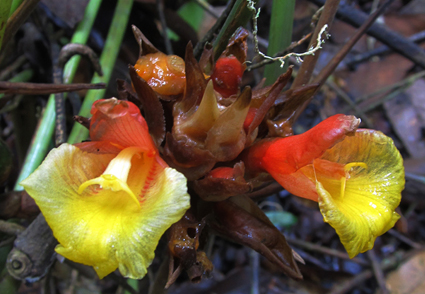Abstract
Conamomum vietnamense, a new species of Zingiberaceae, is described and illustrated from Tay Nguyen (Central Highlands), Vietnam. It is most similar to C. odorum and C. rubidum, but differs in having well-developed stilt roots, elliptic leaf blades, narrowly ovate bracts, abaxially pubescent bracteoles, longer calyx with 2 truncate lobes, broadly obovate to orbicular glabrous labellum, longer filament and glabrous style. Data on distribution, habitat, vernacular name, conservation status and a colour plate of the new species, along with a key to distinguish the species of Conamomum in Cambodia and Vietnam are given.
References
Burtt, B.L. & Smith, R.M. (1972) Key species in the taxonomic history of Zingiberaceae. Notes from the Royal Botanic Garden, Edinburgh 31: 177–227.
de Boer, H., Newman, M., Poulsen, A.D., Droop, A.J., Fér, T., Lê, T.T.H., Hlavatá, K. Lamxay, V., Richardson, J.E., Steffen, K. & Leong-Škorni?ková, J. (2018) Convergent morphology in Alpinieae (Zingiberaceae): Recircumscribing Amomum as a monophyletic genus. Taxon 67 (1): 6–36. https://doi.org/10.12705/671.2
Gagnepain, F. (1906) Zingibéracées nouvelles de l’herbier du muséum. 15e note. Bulletin de la Société botanique de France 53: 132–150.
Gagnepain, F. (1908) Amomum. In: Lecomte, P.H., Fl. Indo-chine 6 (1), xxx, pp. 102–117.
Holttum, R.E. (1950) The Zingiberaceae of the Malay Peninsula. Gardens’ Bulletin Singapore 13: 224–236
IUCN Standards and Petitions Committee (2019) Guidelines for Using the IUCN Red List Categories and Criteria. Version 14. Prepared by the Standards and Petitions Committee. Available from: https://www.iucnredlist.org/resources/redlistguidelines.pdf (accessed 7 April 2020)
Lamxay, V. & Newman, M.F. (2012) A revision of Amomum (Zingiberaceae) in Cambodia, Laos and Vietnam. Edinburgh Journal of Botany 69: 99–206. https://doi.org/10.1017/S0960428611000436
Luu, H.T., Tran, H.D., Nguyen, Q.D., Nguyen, T.Q.T. & Tran, G. (2019) Conamomum odorum, a new species of Zingiberaceae from Central Vietnam. Academia Journal of Biology 41 (3): 55–59. https://doi.org/10.15625/2615-0923/v41n3.13671
Ph?m, H.H. (2000) Amomum. In: Cay Co Vietnam: An illustrated flora of Vietnam 3. Ho Chi Minh City, Nha Xuat Ban Tre. pp. 434–437.
Ridley, H.N. (1899) The Scitamineae of the Malay Peninsula. Journal of the Straits Branch of the Royal Asiatic Society 32: 85–184.
Ridley, H.N. (1909) The Scitamineae of the Philippine islands. Philippine Journal of Science. Section C, Botany 4: 155–199.
Schumann, K.M. (1904) Zingiberaceae. In: Engler, A. (Ed.) Das Pflanzenreich, IV, 46 (Heft 20). Leipzig. pp. 1–458.
Sakai, S. & Nagamasu, H. (1998) Systematic Studies of Bornean Zingiberaceae I. Amomum in Lambir Hills, Sarawak. Edinburgh Journal of Botany 55 (1): 45–64.
Shorthouse, D.P. (2010) SimpleMappr, an online tool to produce publication-quality point maps. Available from: http://www.simplemappr.net (accessed 11 August 2020)
Smith, R.M. (1985) A review of Bornean Zingiberaceae: 1. (Alpineae p.p.). Notes from the Royal Botanic Garden, Edinburgh 42: 261–314.Smith, R.M. (1986) A review of Bornean Zingiberaceae: 2. (Alpineae, concluded). Notes from the Royal Botanic Garden, Edinburgh 43: 439–46. https://doi.org/10.1017/S0960428600004352
Thiers, B. (2018) [continuously updated] Index Herbariorum: A global directory of public herbaria and associated staff. New York Botanical Garden’s Virtual Herbarium. Available from: http://sweetgum.nybg.org/science/ih/ (accessed 20 April 2020)


